Dremel 4000 User Manual

IMPORTANT: |
IMPORTANT : |
IMPORTANTE: |
Read Before Using |
Lire avant usage |
Leer antes de usar |
|
|
|
Operating/Safety Instructions 
 Consignes de fonctionnement/sécurité
Consignes de fonctionnement/sécurité
Instrucciones de funcionamiento y seguridad
4000
P.O. Box 081126 Racine, WI 53408-1126
|
|
Call Toll Free for |
Pour obtenir des informations |
Llame gratis para |
|
|
|
Consumer Information |
et les adresses de nos centres |
obtener información |
|
||
|
|
& Service Locations |
de service après-vente, |
para el consumidor y |
|
|
|
|
|
appelez ce numéro gratuit |
ubicaciones de servicio |
|
|
|
|
|
|
|
||
|
|
1-800-4-DREMEL (1-800-437-3635) www.dremel.com |
|
|
||
|
|
|
|
|
|
|
|
For English Version |
Version française |
Versión en español |
|
||
|
|
See page 2 |
Voir page 41 |
Ver la página 81 |
|
|
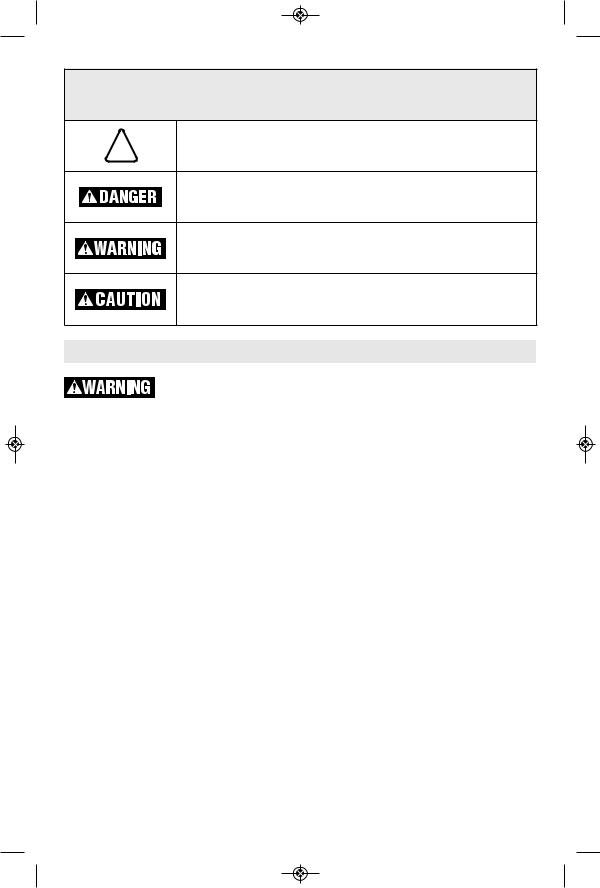
Safety Symbols
The definitions below describe the level of severity for each signal word. Please read the manual and pay attention to these symbols.
This is the safety alert symbol. It is used to alert you to potential
! personal injury hazards. Obey all safety messages that follow this symbol to avoid possible injury or death.
DANGER indicates a hazardous situation which, if not avoided, will result in death or serious injury.
WARNING indicates a hazardous situation which, if not avoided, could result in death or serious injury.
CAUTION, used with the safety alert symbol, indicates a hazardous situation which, if not avoided, will result in minor or moderate injury.
General Power Tool Safety Warnings
Read all safety warnings and all instructions. Failure to follow the warnings and instructions may result in electric shock, fire and/or serious injury.
SAVE ALL WARNINGS AND INSTRUCTIONS FOR FUTURE REFERENCE
The term “power tool” in the warnings refers to your mains-operated (corded) power tool or battery-operated (cordless) power tool.
Work area safety
Keep work area clean and well lit. Cluttered or dark areas invite accidents.
Do not operate power tools in explosive atmospheres, such as in the presence of flammable liquids, gases or dust. Power tools create sparks which may ignite the dust or fumes.
Keep children and bystanders away while operating a power tool. Distractions can cause you to lose control.
Electrical safety
Power tool plugs must match the outlet. Never modify the plug in any way. Do not use any adapter plugs with earthed (grounded) power tools. Unmodified plugs and matching outlets will reduce risk of electric shock.
Avoid body contact with earthed or grounded surfaces such as pipes, radiators, ranges and refrigerators. There is an increased risk of electric shock if your body is earthed or grounded.
2
Do not expose power tools to rain or wet conditions. Water entering a power tool will increase the risk of electric shock.
Do not abuse the cord. Never use the cord for carrying, pulling or unplugging the power tool. Keep cord away from heat, oil, sharp edges or moving parts. Damaged or entangled cords increase the risk of electric shock.
When operating a power tool outdoors, use an extension cord suitable for outdoor use. Use of a cord suitable for outdoor use reduces the risk of electric shock.
IIf operating a power tool in a damp location is unavoidable, use a Ground Fault Circuit Interrupter (GFCI) protected supply. Use of an GFCI reduces the risk of electric shock.
Personal safety
Stay alert, watch what you are doing and use common sense when operating a power tool. Do not use a power tool while you are tired or under the influence of drugs, alcohol or medication. A moment of inattention while operating power tools may result in serious personal injury.

Use personal protective equipment. Always wear eye protection. Protective equipment such as dust mask, non-skid safety shoes, hard hat, or hearing protection used for appropriate conditions will reduce personal injuries.
Prevent unintentional starting. Ensure the switch is in the off-position before connecting to power source and / or battery pack, picking up or carrying the tool.
Carrying power tools with your finger on the switch or energizing power tools that have the switch on invites accidents.
Remove any adjusting key or wrench before turning the power tool on. A wrench or a key left attached to a rotating part of the power tool may result in personal injury.
Do not overreach. Keep proper footing and balance at all times. This enables better control of the power tool in unexpected situations.
Dress properly. Do not wear loose clothing or jewelry. Keep your hair, clothing and gloves away from moving parts. Loose clothes, jewelry or long hair can be caught in moving parts.
If devices are provided for the connection of dust extraction and collection facilities, ensure these are connected and properly used. Use of dust collection can reduce dustrelated hazards.
Power tool use and care
Do not force the power tool. Use the correct power tool for your application. The correct power tool will do the job better and safer at the rate for which it was designed.
Do not use the power tool if the switch does not turn it on and off. Any power tool that
cannot be controlled with the switch is dangerous and must be repaired.
Disconnect the plug from the power source and/or the battery pack from the power tool before making any adjustments, changing accessories, or storing power tools. Such preventive safety measures reduce the risk of starting the power tool accidentally.
Store idle power tools out of the reach of children and do not allow persons unfamiliar with the power tool or these instructions to operate the power tool. Power tools are dangerous in the hands of untrained users.
Maintain power tools. Check for misalignment or binding of moving parts, breakage of parts and any other condition that may affect the power tool’s operation. If damaged, have the power tool repaired before use.
Many accidents are caused by poorly maintained power tools.
Keep cutting tools sharp and clean. Properly maintained cutting tools with sharp cutting edges are less likely to bind and are easier to control.
Use the power tool, accessories and tool bits etc. in accordance with these instructions, taking into account the working conditions and the work to be performed. Use of the power tool for operations different from those intended could result in a hazardous situation.
Service
Have your power tool serviced by a qualified repair person using only identical replacement parts. This will ensure that the safety of the power tool is maintained.
|
|
|
|
|
Safety Rules for Rotary Tools |
||
|
Safety warnings common for |
Do not use accessories which are not |
|
|
grinding, sanding, wire brushing, |
specifically designed and recommended by |
|
|
polishing, carving or abrasive |
the tool manufacturer. Just because the |
|
|
cutting-off operations: |
accessory can be attached to your power tool, |
|
|
it does not assure safe operation. |
||
This power tool is intended to function as a |
The RATED SPEED of the accessories |
||
grinder, sander, wire brush, polisher, |
must be at least equal to the operating |
|
carving or cut-off tool. Read all safety |
||
speed setting marked on the power tool. |
||
warnings, instructions, illustrations and |
||
Accessories running faster than their RATED |
||
specifications provided with this power |
||
SPEED can break and fly apart. |
||
tool. Failure to follow all instructions listed |
||
The outside diameter and the thickness of |
||
below may result in electric shock, fire and/or |
||
your accessory must be within the capacity |
||
serious injury. |
||
rating of your power tool. Incorrectly sized |
||
|
3

Safety Rules for Rotary Tools - (cont.)
accessories cannot be adequately guarded or controlled.
The arbor size of wheels, sanding drums or any other accessory must properly fit the spindle or collet of the power tool.
Accessories that do not match the mounting hardware of the power tool will run out of balance, vibrate excessively and may cause loss of control.
Mandrel mounted wheels, sanding drums, cutters or other accessories must be fully inserted into the collet or chuck. If the mandrel is insufficiently held and/or the overhang of the wheel is too long, the mounted wheel may become loose and be ejected at high velocity.
Do not use a damaged accessory. Before each use inspect the accessory such as abrasive wheels for chips and cracks, sanding drum for cracks, tear or excess wear, wire brush for loose or cracked wires. If power tool or accessory is dropped, inspect for damage or install an undamaged accessory. After inspecting and installing an accessory, position yourself and bystanders away from the plane of the rotating accessory and run the power tool at maximum no-load speed for one minute.
Damaged accessories will normally break apart during this test time.
Wear personal protective equipment. Depending on application, use face shield, safety goggles or safety glasses. As appropriate, wear dust mask, hearing protectors, gloves and workshop apron capable of stopping small abrasive or workpiece fragments. The eye protection must be capable of stopping flying debris generated by various operations. The dust mask or respirator must be capable of filtrating particles generated by your operation. Prolonged exposure to high intensity noise may cause hearing loss.
Keep bystanders a safe distance away from work area. Anyone entering the work area must wear personal protective equipment.
Fragments of workpiece or of a broken accessory may fly away and cause injury beyond immediate area of operation.
Hold the power tool by insulated gripping surfaces only, when performing an operation where the cutting accessory may contact hidden wiring or its own cord.
Cutting accessory contacting a “live” wire may make exposed metal parts of the power tool “live” and could give the operator an electric shock.
Always hold the tool firmly in your hand(s) during the start-up. The reaction torque of the motor, as it accelerates to full speed, can cause the tool to twist.
Use clamps to support workpiece whenever practical. Never hold a small workpiece in one hand and the tool in the other hand while in use. Clamping a small workpiece allows you to use your hand(s) to control the tool. Round material such as dowel rods, pipes or tubing have a tendency to roll while being cut, and may cause the bit to bind or jump toward you.
Position the cord clear of the spinning accessory. If you lose control, the cord may be cut or snagged and your hand or arm may be pulled into the spinning accessory.
Never lay the power tool down until the accessory has come to a complete stop.
The spinning accessory may grab the surface and pull the power tool out of your control.
After changing the bits or making any adjustments, make sure the collet nut, chuck or any other adjustment devices are securely tightened. Loose adjustment devices can unexpectedly shift, causing loss of control, loose rotating components will be violently thrown.
Do not run the power tool while carrying it at your side. Accidental contact with the spinning accessory could snag your clothing, pulling the accessory into your body.
Regularly clean the power tool’s air vents.
The motor’s fan will draw the dust inside the housing and excessive accumulation of powdered metal may cause electrical hazards.
Do not operate the power tool near flammable materials. Sparks could ignite these materials.
Do not use accessories that require liquid coolants. Using water or other liquid coolants may result in electrocution or shock.
Use only in well-ventilated area. Working in a safe environment reduces risk of injury.
Allow for sufficient space, at least 6”, between your hand and the spinning bit. Do not reach in the area of the spinning bit. The proximity of the spinning bit to your hand may not always be obvious.
4

Safety Rules for Rotary Tools - (cont.)
Do not touch the bit or collet after use. After use the bit and collet are too hot to be touched by bare hands.
Do not alter or misuse tool. Any alteration or modification is a misuse and may result in serious personal injury.
This product is not intended for use as a dental drill, in human or veterinary medical applications. Serious injury may result.
Kickback and Related Warnings
Kickback is a sudden reaction to a pinched or snagged rotating wheel, backing pad, brush or any other accessory. Pinching or snagging causes rapid stalling of the rotating accessory which in turn causes the uncontrolled power tool to be forced in the direction opposite of the accessory’s rotation.
For example, if an abrasive wheel is snagged or pinched by the workpiece, the edge of the wheel that is entering into the pinch point can dig into the surface of the material causing the wheel to climb out or kickout. The wheel may either jump toward or away from the operator, depending on direction of the wheel’s movement at the point of pinching. Abrasive wheels may also break under these conditions. Kickback is the result of power tool misuse and/or incorrect operating procedures or conditions and can be avoided by taking proper precautions as given below.
Maintain a firm grip on the power tool and position your body and arm to allow you to resist kickback forces. The operator can control kickback forces, if proper precautions are taken.
Use special care when working corners, sharp edges etc. Avoid bouncing and snagging the accessory. Corners, sharp edges or bouncing have a tendency to snag the rotating accessory and cause loss of control or kickback.
Do not attach a toothed saw blade. Such blades create frequent kickback and loss of control.
Always feed the bit into the material in the same direction as the cutting edge is exiting from the material (which is the same direction as the chips are thrown). Feeding the tool in the wrong direction causes the cutting edge of the bit to climb out of the work and pull the tool in the direction of this feed.
When using rotary files, cut-off wheels,
high-speed cutters or tungsten carbide cutters, always have the work securely clamped. These wheels will grab if they become slightly canted in the groove, and can kickback. When a cut-off wheel grabs, the wheel itself usually breaks. When a rotary file, high-speed cutter or tungsten carbide cutter grabs, it may jump from the groove and you could lose control of the tool.
Safety warnings specific for grinding and abrasive cutting-off operations:
Use only wheel types that are recommended for your power tool and only for recommended applications. For example: do not grind with the side of a cutoff wheel. Abrasive cut-off wheels are intended for peripheral grinding, side forces applied to these wheels may cause them to shatter.
For threaded abrasive cones and plugs use only undamaged wheel mandrels with an unrelieved shoulder flange that are of correct size and length. Proper mandrels will reduce the possibility of breakage.
Do not ′′jam′′ a cut-off wheel or apply excessive pressure. Do not attempt to make an excessive depth of cut. Overstressing the wheel increases the loading and susceptibility to twisting or snagging of the wheel in the cut and the possibility of kickback or wheel breakage.
Do not position your hand in line with and behind the rotating wheel. When the wheel, at the point of operation, is moving away from your hand, the possible kickback may propel the spinning wheel and the power tool directly at you.
When wheel is pinched, snagged or when interrupting a cut for any reason, switch off the power tool and hold the power tool motionless until the wheel comes to a complete stop. Never attempt to remove the cut-off wheel from the cut while the wheel is in motion otherwise kickback may occur.
Investigate and take corrective action to eliminate the cause of wheel pinching or snagging.
Do not restart the cutting operation in the workpiece. Let the wheel reach full speed and carefully re-enter the cut. The wheel may bind, walk up or kickback if the power tool is restarted in the workpiece.
5
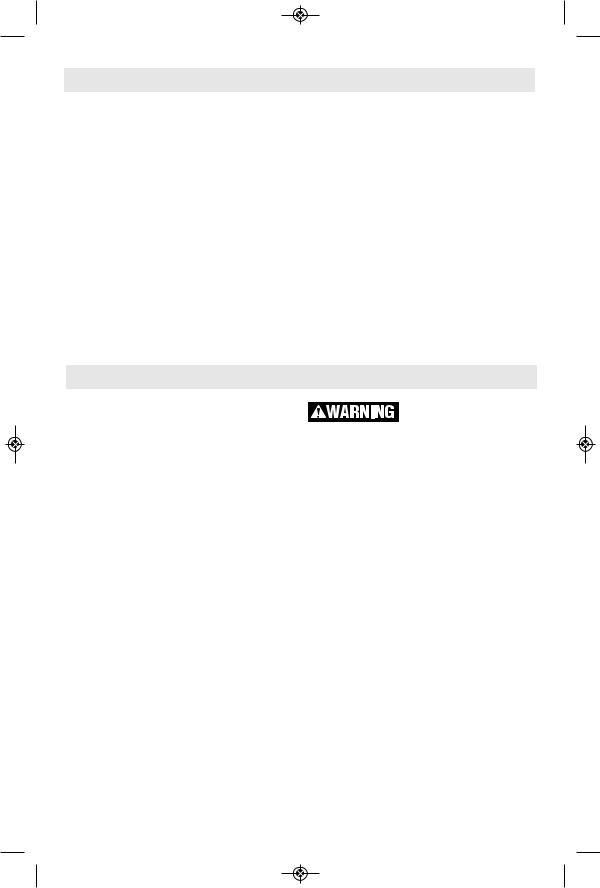
Safety Rules for Rotary Tools - (cont.)
Support panels or any oversized workpiece to minimize the risk of wheel pinching and kickback. Large workpieces tend to sag under their own weight. Supports must be placed under the workpiece near the line of cut and near the edge of the workpiece on both sides of the wheel.
Use extra caution when making a ′′pocket cut′′ into existing walls or other blind areas.
The protruding wheel may cut gas or water pipes, electrical wiring or objects that can cause kickback.
Safety warnings specific for wire brushing operations:
Be aware that wire bristles are thrown by the brush even during ordinary operation.
Do not overstress the wires by applying excessive load to the brush. The wire bristles can easily penetrate light clothing and/or skin.
Allow brushes to run at operating speed for at least one minute before using them. During this time no one is to stand in front or in line with the brush. Loose bristles or wires will be discharged during the run-in time.
Direct the discharge of the spinning wire brush away from you. Small particles and tiny wire fragments may be discharged at high velocity during the use of these brushes and may become imbedded in your skin.
Additional Safety Warnings
GFCI and personal protection devices like electrician’s rubber gloves and footwear will further enhance your personal safety.
Do not use AC only rated tools with a DC power supply. While the tool may appear to work, the electrical components of the AC rated tool are likely to fail and create a hazard to the operator.
Keep handles dry, clean and free from oil and grease. Slippery hands cannot safely control the power tool.
Use clamps or other practical way to secure and support the workpiece to a stable platform. Holding the work by hand or against your body is unstable and may lead to loss of control.
Develop a periodic maintenance schedule for your tool. When cleaning a tool be careful not to disassemble any portion of the tool since internal wires may be misplaced or pinched or safety guard return springs may be improperly mounted.
Certain cleaning agents such as gasoline, carbon tetrachloride, ammonia, etc. may damage plastic parts.
Risk of injury to user. The power cord must only be serviced by a Dremel Service Facility.
Some dust created by power sanding, sawing, grinding, drilling, and other construction
activities contains chemicals known to cause cancer, birth defects or other reproductive harm. Some examples of these chemicals are:
• Lead from lead-based paints,
• Crystalline silica from bricks and cement and other masonry products, and
• Arsenic and chromium from chemicallytreated lumber.
Your risk from these exposures varies, depending on how often you do this type of work. To reduce your exposure to these chemicals: work in a well ventilated area, and work with approved safety equipment, such as those dust masks that are specially designed to filter out microscopic particles.
6
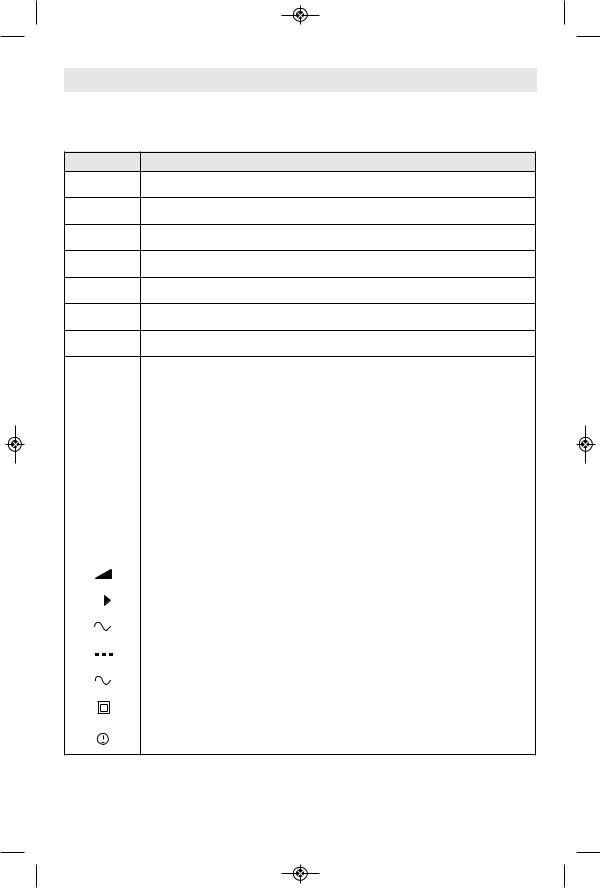
Symbols
IMPORTANT: Some of the following symbols may be used on your tool. Please study them and learn their meaning. Proper interpretation of these symbols will allow you to operate the tool better and safer.
Symbol |
Designation / Explanation |
V |
Volts (voltage) |
A |
Amperes (current) |
Hz |
Hertz (frequency, cycles per second) |
W |
Watt (power) |
kg |
Kilograms (weight) |
min |
Minutes (time) |
s |
Seconds (time) |
Diameter (size of drill bits, grinding wheels, etc.)
|
|
|
|||||
|
n0 |
No load speed (rotational speed at no load) |
|||||
|
|
n |
Rated speed (maximum attainable speed) |
||||
|
|
|
|
|
|
|
|
.../min |
Revolutions or reciprocation per minute (revolutions, strokes, surface speed, |
||||||
orbits etc. per minute) |
|||||||
|
|
|
|
|
|
||
|
|
|
|
||||
0 |
|
|
Off position (zero speed, zero torque...) |
||||
|
|
||||||
1, 2, 3, ... |
Selector settings (speed, torque or position settings. Higher number means |
||||||
I, II, III, |
greater speed) |
||||||
|
|
|
|
|
|
||
0 |
|
|
|
|
Infinitely variable selector with off (speed is increasing from 0 setting) |
||
|
|
|
|
|
|
|
|
|
|
|
|
|
|
Arrow (action in the direction of arrow) |
|
|
|
|
|
|
|
|
|
|
|
|
|
|
|
Alternating current (type or a characteristic of current) |
|
|
|
|
|
|
|
|
|
|
|
|
|
|
|
Direct current (type or a characteristic of current) |
|
|
|
|
|
|
|
||
|
|
|
|
|
|
|
|
|
|
|
|
|
|
Alternating or direct current (type or a characteristic of current) |
|
|
|
|
|
|
|
||
|
|
|
|
|
|
|
|
|
|
|
|
|
|
Class II construction (designates double insulated construction tools) |
|
|
|
|
|
|
|
|
|
|
|
|
|
|
|
Earthing terminal (grounding terminal) |
|
|
|
|
|
|
|
||
7
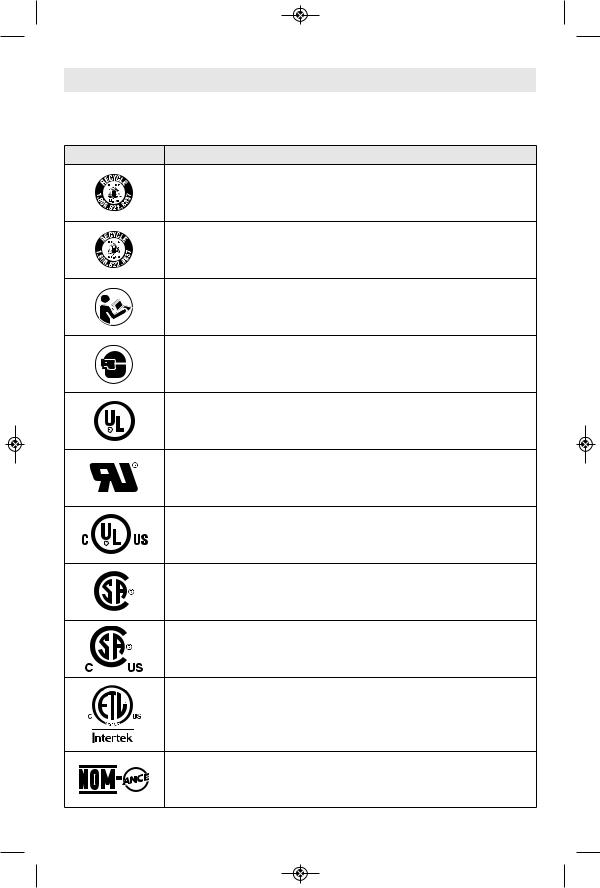
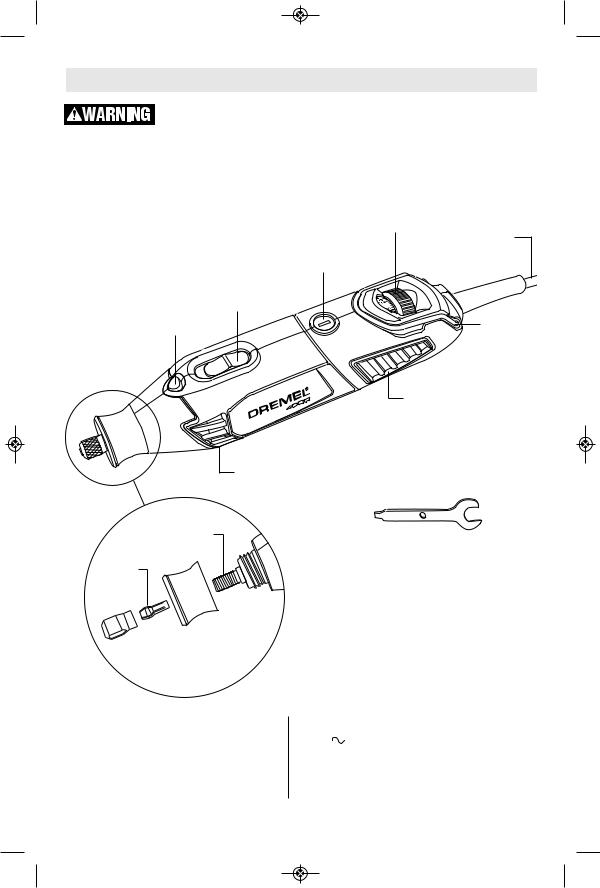
Functional Description and Specifications
Disconnect the plug from the power source before making any assembly, adjustments or changing accessories. Such preventive
safety measures reduce the risk of starting the tool accidentally.
Model 4000 High Speed Rotary Tool
VARIABLE SPEED
DIAL
CORD
BRUSH COVER (one on each side)
ON/OFF
SWITCH
SHAFT LOCK |
HANGER |
|
BUTTON |
||
|
R
VENTILATION OPENINGS
VENTILATION
OPENINGS
SHAFT |
COLLET |
|
WRENCH |
COLLET
|
COLLET |
|
EZ TWIST™ |
|
|
|
|||
|
|
INTEGRATED |
||
|
|
NUT |
|
|
|
|
WRENCH/NOSE CAP |
||
|
|
|
||
|
|
|
Model number |
4000 |
|
Voltage rating |
120V |
60Hz |
Amperage rating |
1.6A |
|
Rated speed |
n 5,000/35,000/min |
|
Collet capacities |
1/32, 1/16", 3/32", 1/8" |
|
9
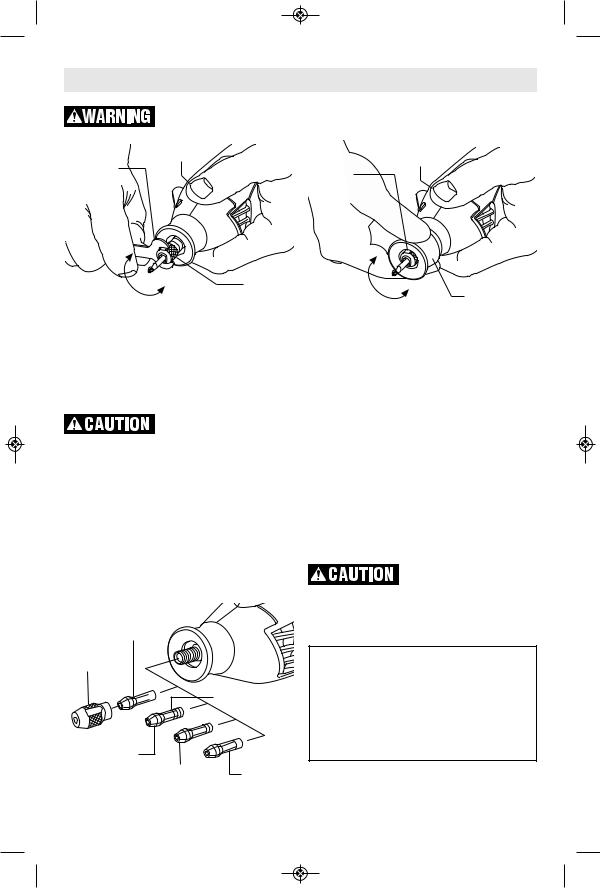
Assembly
Always unplug Rotary Tool before changing accessories, changing collets or servicing your Rotary Tool.
SHAFT LOCK |
SHAFT LOCK |
|
BUTTON |
BUTTON |
|
COLLET |
COLLET |
|
WRENCH |
||
NUT |
||
|
TO |
TO |
COLLET |
|
NUT |
|||
TIGHTEN |
LOOSEN |
||
|
COLLET NUT — To loosen, first press shaft lock button and rotate the shaft by hand until the lock engages the shaft preventing further rotation. Your Dremel 4000 is equipped with a quick collet lock mechanism. This mechanism engages the output shaft in 8 separate locations on the shaft for easier operation.
Do not engage lock while the Rotary Tool is running.
With the shaft lock engaged use the collet wrench to loosen the collet nut if necessary. The collet nut must be loosely threaded on when inserting an accessory. Change accessories by inserting the new one into the collet as far as
COLLETS — Four different size collets (see illus tration), to accommodate different shank sizes, are avail able for your Rotary Tool. To install a different collet, remove the collet nut and remove the old collet. Insert the unslotted
480
1/8" COLLET
COLLET
NUT
|
|
IDENTIFICATION |
|
|
|
RINGS |
|
481 |
|
|
|
3/32" |
|
483 |
|
COLLET |
482 |
||
1/32" |
|||
|
|||
|
1/16" |
||
|
COLLET |
||
|
COLLET |
||
|
|
|
TO |
EZ TWIST™ |
TO |
INTEGRATED |
|
TIGHTEN |
LOOSEN |
WRENCH/NOSE CAP |
possible to minimize runout and unbalance. With the shaft lock engaged, finger tighten the collet nut until the accessory shank is gripped by the collet. Avoid excessive tightening of the collet nut when there is no bit inserted.
EZ TWIST™ INTEGRATED
WRENCH/NOSE CAP
The nose cap of your tool has an integrated wrench allowing you to loosen and tighten the collet nut without the use of the standard collet wrench. Unscrew the nose cap from the tool, line-up steel insert on inside of cap with collet nut. With the shaft lock engaged twist nose cap clockwise to tighten, and counter-clockwise to loosen.
end of the collet in the hole in the end of the tool shaft. Replace collet nut on the shaft.
Always use the collet which matches the shank size of the accessory you plan to use. Never
force a larger diameter shank into a collet. Note: Most rotary tool kits do not include all four collets sizes.
COLLET IDENTIFICATION CHART
Collet sizes can be identified by the rings on the back end of collet.
1/32" Collet has one (1) ring. 1/16" Collet has two (2) rings. 3/32" Collet has three (3) rings.
1/8" Collet has no rings. (Included in most tool kits on the tool)
10

BALANCING ACCESSORIES — For precision |
The hanger is provided for the use of hanging |
|
work, it is important that all accessories be in |
your tool while using the flex-shaft or for |
|
good balance (much the same as the tires on |
storage. If you do not use the hanger, snap it |
|
your automobile). To true up or balance an |
back into place so it will be out of the way while |
|
accessory, slightly loosen collet nut and give |
the tool is in use. |
|
the accessory or collet a 1/4 turn. Re tighten |
|
|
collet nut and run the Rotary Tool. You should |
|
|
be able to tell by the sound and feel if your |
|
|
accessory is running in balance. Continue |
|
|
adjusting in this fashion until best balance is |
|
|
achieved. To maintain balance on abrasive |
|
|
wheel points, before each use, with the wheel |
FIxING STUCK COLLETS – It is possible for a |
|
point secured in the collet, turn on the Rotary |
collet to get stuck within the collet nut especially if |
|
Tool and run the 415 Dressing Stone lightly |
a collet nut is tightened onto the tool without a bit |
|
against the revolving wheel point. This removes |
in place. If this happens, the collet can be |
|
high spots and trues up the wheel point for |
removed from the collet nut by pushing the shank |
|
good balance. |
of an accessory into the hole in the collet nut. |
|
|
This should cause the collet to pop out of the |
|
|
collet nut. |
|
|
|
|
Operating Instructions |
||
Dremel 4000 |
speed, you have to know that the standard |
|
Thank you for purchasing the Dremel 4000. |
portable electric drill runs at speeds up to 2,800 |
|
This product was designed by the many |
revolutions per minute. The Rotary Tool |
|
Dremel users who passionately use their rotary |
operates at speeds up to 35,000 revolutions |
|
tools daily. This tool was designed to give you |
per minute. The typical electric drill is a low- |
|
the ultimate performance when working on |
speed, high torque tool; the Rotary Tool is just |
|
projects. |
the opposite – a high-speed, low torque tool. |
|
The Dremel 4000 is the MOST versatile rotary |
The major difference to the user is that in the |
|
tool available today. It has a wide speed range |
high speed tools, the speed combined with the |
|
including a high performance motor with |
acces sory mounted in the collet does the work. |
|
electronic feedback that allows the tool to |
You don’t apply pressure to the tool, but simply |
|
maintain its speed under load. The design of |
hold and guide it. In the low speed tools, you |
|
the tool is symmetrical and contains plenty of |
not only guide the tool, but also apply pressure |
|
soft grip so the tool can be held comfortably in |
to it, as you do, for example, when drilling a hole. |
|
many positions. The quick collet lock |
It is this high speed, along with its compact size |
|
mechanism makes locking the output shaft |
and wide variety of special accessories and |
|
easier for changing accessories. You will |
attachments, that makes the Rotary Tool differ- |
|
appreciate the many applications that the |
ent from other tools. The speed enables it to do |
|
Dremel 4000 can easily tackle. |
jobs low speed tools cannot do, such as cutting |
|
Rotary Tool Introduction |
hardened steel, en graving glass, etc. |
|
The Rotary Tool has a small, powerful electric |
Getting the most out of your Rotary Tool is a |
|
universal motor, is comfort able in the hand, and |
matter of learning how to let this speed work for |
|
is made to accept a large variety of accessories |
you. To learn about more uses and the |
|
including abrasive wheels, drill bits, wire |
versatility of Dremel accessories and |
|
brushes, polishers, engraving cutters, router |
attachments refer to this Owner's Manual or |
|
bits, cutting wheels and attachments. |
check our website at www.Dremel.com. |
|
Accessories come in a variety of shapes and |
Using the Rotary Tool |
|
permit you to do a number of different jobs. As |
The first step in learning to use the Rotary Tool |
|
you be come familiar with the range of |
is to get the “feel” of it. Hold it in your hand and |
|
accessories and their uses, you will learn just |
feel its weight and balance. Feel the taper of |
|
how versatile the Rotary Tool is. You’ll see |
the housing. This taper permits the Rotary Tool |
|
dozens of uses you hadn’t thought of before. |
to be grasped much like a pen or pencil |
|
The real secret of the Rotary Tool is its speed. |
(Figure A). |
|
To understand the advantages of its high |
|
|
|
11 |
|
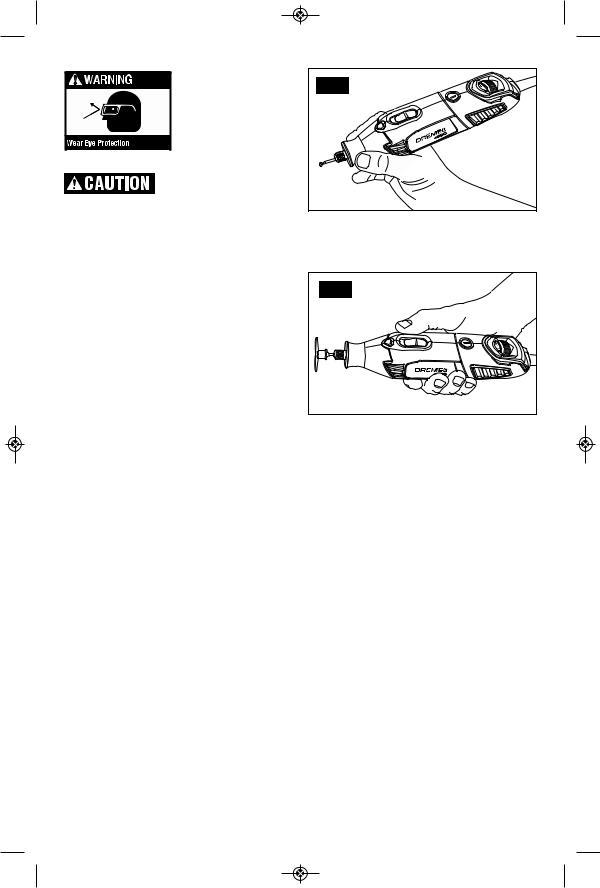
Always hold the tool away from your face. Accessories can be damaged during handling, and can fly apart as they come up to speed. This is not
common, but it does happen.
Whenever you hold the tool, be careful not to cover the air vents with your hand. This
blocks the air flow and causes the motor to overheat.
Practice on scrap materials first to see how the Rotary Tool's high speed action performs. Keep in mind that the work is done by the speed of the tool and by the accessory in the collet. You should not lean on or push the tool during use.
Instead, lower the spinning accessory lightly to the work and allow it to touch the point at which you want cutting (or sanding or etching, etc.) to begin. Con centrate on guiding the tool over the work using very little pressure from your hand. Allow the accessory to do the work.
Usually, it is best to make a series of passes with the tool rather than attempt to do all the work in one pass. To make a cut, for example, pass the tool back and forth over the work, much as you would a small paint brush. Cut a little material on each pass until you reach the desired depth. For most work, the gentle touch is best. With it, you have the best control, are less likely to make errors, and will get the most effi cient work out of the accessory.
FIG. A
For best control in close work, grip the Rotary Tool like a pencil between your thumb and forefinger.
FIG. B
The “Golf Grip” method of holding the tool is used for more aggressive operations such as grinding a flat surface or using cutoff wheels.
Questions or Problems? Call 1-800-437-3635 or check our website at www.Dremel.com
12

Operating Speeds
To select the right speed for each job, use a practice piece of material.
NOTE: Speed is affected by voltage changes. A reduced incoming voltage will slow the RPM of the tool.
SLIDE "ON/OFF" SWITCH
The tool is switched "ON" by the slide switch located on the topside of the motor housing. TO TURN THE TOOL "ON", slide the switch button forward.
TO TURN THE TOOL "OFF", slide the switch button backward.
HIGH PERFORMANCE MOTOR
Your tool is equipped with a high performance rotary tool motor. This motor expands the versatility of the rotary tool by driving additional attachments such as the Dremel Multi-Saw and Dremel Planer.
ELECTRONIC FEEDBACK
Your tool is equipped with an internal electronic feedback system that provides a “soft start”, which will reduce the stresses that occur from a high torque start. The system also helps to keep the preselected speed virtually constant between no-load and load conditions.
VARIABLE SPEED DIAL
Your tool is equipped with a variable speed dial. The speed may be adjusted during operation by presetting the dial on or between any one of the settings.
You can refer to the charts on page 24, 25, 26 and 27 to determine the proper speed, based on the materi al being worked and the type of accessory being used. These charts enable you to select both the correct acces sory and the optimum speed at a glance.
The speed of Rotary Tool is controlled by setting this dial on the housing.
Settings for Approximate Revolutions. |
|
|
|
Switch Setting |
Speed Range |
5 |
15,000-7,000 RPM |
*10 |
17,000-10,000 RPM |
15 |
13,000-17,000 RPM |
20 |
18,000-23,000 RPM |
25 |
23,000-27,000 RPM |
30 |
28,000-32,000 RPM |
35 |
33,000-35,000 RPM |
* Wire Brush Setting. |
|
Needs for Slower Speeds
Certain materials, however, (some plastics and precious metals, for ex ample) require a relatively slow speed because at high speed the friction of the accessory generates heat and may cause damage to the material.
Slow speeds (15,000 RPM or less) usually are best for polishing operations employing the felt polishing ac ces sories. They may also be best for working on deli cate projects as “eggery” work, delicate wood carving and fragile model parts. (All brushing applications require lower speeds to avoid wire discharge from the holder.)
Higher speeds are better for carving, cutting, routing, shaping, cutting dadoes or rabbets in wood.
Hardwoods, metals and glass require high speed operation, and drilling should also be done at high speeds.
The point to remember is this: Many applications and accessories in our line will provide the best performance at full speed, but for certain materials, applications, and accessories, you need slower speeds, which is the reason our variable speed models are available.
13
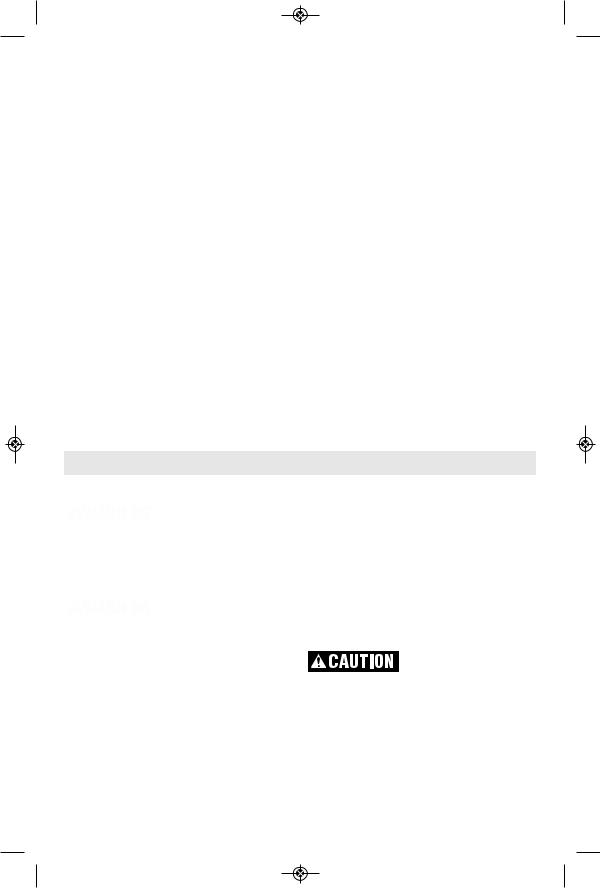
To aid you in determining the optimum operational speed for differ ent materials and different accessories, we have construct ed a series of tables that appear on page 24, 25, 26 and 27. By referring to these tables, you can discover the recommended speeds for each type of accessory. Look these tables over and become familiar with them.
Ultimately, the best way to determine the correct speed for work on any material is to practice for a few minutes on a piece of scrap, even after referring to the chart. You can quickly learn that a slower or faster speed is more effective just by observing what hap pens as you make a pass or two at different speeds. When working with plastic, for example, start at a slow rate of speed and increase the speed until you observe that the plastic is melting at the point of contact. Then reduce the speed slight yl to get the optimum working speed.
Some rules of thumb in regard to speed:
1. Plastic and other materials that melt at low temperatures should be cut at low speeds.
2. Polishing, buffing and cleaning with any type of bristle brush must be done at speeds not greater than 15,000 RPM to prevent damage to the brush.
3. Wood should be cut at high speed.
4. Iron or steel should be cut at high speed. If a high speed steel cutter starts to chatter — this normally means it is running too slow.
5. Aluminum, copper alloys, lead alloys, zinc alloys and tin may be cut at various speeds, depending on the type of cutting being done. Use paraffin or other suitable lubricant on the cutter to prevent the cut material from adhering to the cutter teeth.
Increasing the pressure on the tool is not the answer when it is not performing as you think it should. Perhaps you should be using a different accessory, and perhaps an adjustment in speed would solve the problem. Leaning on the tool does not help.
Let speed do the work!
Use only Dremel®, high-performance accessories.
|
|
Service |
|
|
|
Preventive maintenance |
|
|
|
||
|
|
pe rformed |
by |
|
|
||
unauthorized per so n nel may result in |
|||
misplacing of internal wires and |
|||
components which could cause serious |
|||
hazard. We recommend that all tool service |
|||
be performed by a Dremel Service Facility. |
|
||
|
|
To avoid injury from |
|
|
|
||
|
|
unexpected starting or |
|
electrical shock, always remove plug from |
|||
wall outlet |
before performing service or |
||
cleaning. |
CARBON BRUSHES |
|
|
The brushes and commutator in your tool have been engineered for many hours of dependable service.
In order to prepare your brushes for use, run your tool at full speed for 5 minutes under no load. This will properly “seat” your brushes, which extends the life of both your brushes and your tool.
To maintain peak efficiency of the motor, we recommend every 40 - 50 hours the brush es be examined. Only genuine Dremel replacement brushes specially designed for your tool should be used.
MAINTENANCE OF REPLACEABLE
BRUSHES ON MODEL 4000
The brushes should be inspected frequently when tools are used continuously. If your tool runs spo rad ically, loses power, makes unusual noises or runs at a reduced speed, check the brushes.To continue using the
tool in this condition will permanently damage your tool.
Follow these steps to check/change the rotary tool brushes:
1. With the power cord unplugged, place the tool on a clean surface. Use the tool wrench as a screwdriver to remove the brush caps in a counter-clockwise direction (Figure C).
14
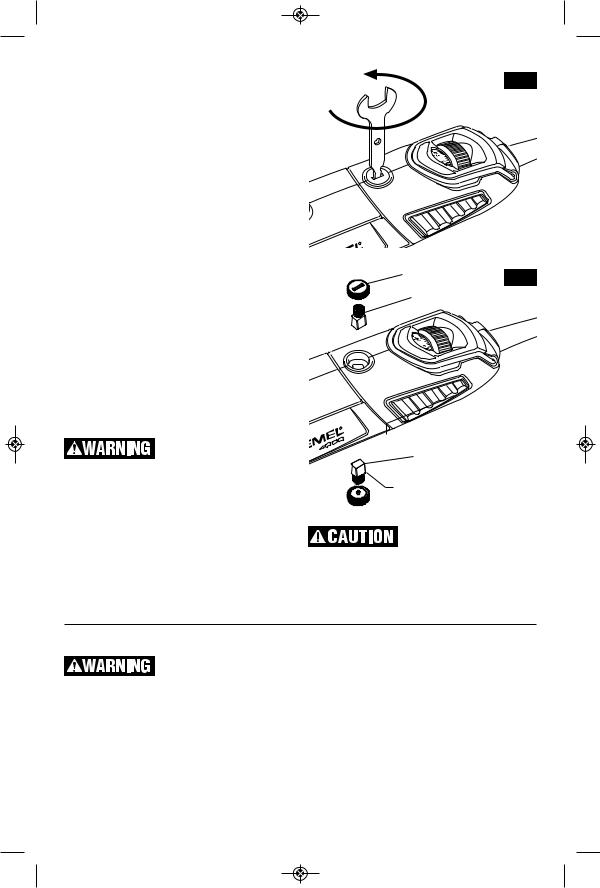
2. Remove the brushes from the tool by pulling on the spring that is attached to the carbon brush. If the brush is less than 1/8" long and the end surface of the brush that contacts the commutator is rough and/or pitted, they should be replaced. Check both brushes (Figure D).
Usually the brushes will not wear out simultaneously. If one brush is worn out, replace both brushes. Make sure the brushes are installed as illus ratedt. The curved surface of the brush must match the curvature of the commutator. Also check that the brush caps sit flush with the tool housing.
3. After replacing brushes the tool should be run at no-load; place it on a clean surface and run it freely at full speed for 5 minutes before loading (or using) the tool. This will allow the brushes to “seat” properly and will give you more hours of life from each set of brushes. This will also extend the total life of your tool since the com mutator surface will “wear” longer.
BEARINGS
Model 4000 has ball bearing construction. Under normal use no additional lubrication is required. Cleaning
To avoid accidents always dis connect the tool from the power supply before
cleaning or performing any main tenance.
The tool may be cleaned most effectively with compressed dry air. Always wear safety gog gles when cleaning tools with compressed air.
Ventilation openings and switch levers must be kept clean and free of foreign matter. Do not at tempt to clean by inserting pointed objects through openings.
Extension Cords
If an extension cord is necessary, a cord with adequate size conductors that is capable
of carrying the current necessary for your tool must be used. This will prevent excessive voltage drop, loss of power or overheating. Grounded tools must use 3-wire extension cords that have 3-prong plugs and receptacles.
NOTE: The smaller the gauge number, the higher the cord capacity.
FIG. C
R
BRUSH CAP |
FIG. D |
BRUSH SPRING
R
Curved end of brush must match curvature of commutator
BRUSH
Certain cleaning agents plastic parts. and sol vents damage
Some of these are: gasoline, carbon tetrachlo ride, chlo rinated cleaning solvents, ammonia and house hold detergents that contain ammonia.
RECOMMENDED SIZES OF ExTENSION CORDS |
|||||||||
120 VOLT ALTERNATING CURRENT TOOLS |
|||||||||
Tool’s |
Cord Size in A.W.G. |
Wire Sizes in mm2 |
|||||||
|
|
|
|
|
|
|
|
||
Ampere |
Cord Length in Feet |
Cord Length in Meters |
|||||||
Rating |
|
|
|
|
|
|
|
|
|
25 |
50 |
100 |
150 |
15 |
30 |
60 |
120 |
||
|
|||||||||
3-6 |
18 |
16 |
16 |
14 |
0.75 |
0.75 |
1.5 |
2.5 |
|
6-8 |
18 |
16 |
14 |
12 |
0.75 |
1.0 |
2.5 |
4.0 |
|
8-10 |
18 |
16 |
14 |
12 |
0.75 |
1.0 |
2.5 |
4.0 |
|
10-12 |
16 |
16 |
14 |
12 |
1.0 |
2.5 |
4.0 |
– |
|
12-16 |
14 |
12 |
– |
– |
– |
– |
– |
– |
|
15

Dremel Accessories
Use only Dremel®, high-performance accessories. Other accessories are not designed for this tool and may lead to personal injury or property damage.
Store accessories in a dry and temperate environment to avoid corrosion and deterioration.
The number and variety of accessories for the Rotary Tool are almost limitless. There is a category suited to almost any job you might have to do and a variety of sizes and shapes within each category which en ables you to get the perfect accessory for every need.
COLLETS
If you expect to use a variety of accessories, we recommend that in the beginning you purchase a complete set of four collets. Store these so that you will have the proper size of collet for any accessory or drill bit you want to use. Currently, the 1/8", 3/32",1/32" and
1/16" collets accommodate all of the available Dremel accessories. 1/8" collets are included in most rotary tool kits.
MANDRELS
A mandrel is a shank with a threaded or screw head, which are required when you use polishing accessories, cutting wheels, sanding discs, and pol ish ing points. The reason mandrels are used is that sanding discs, cutting wheels and similar accesso ries must be replaced frequently. The mandrel is a permanent shank, allowing you to replace only the worn head when necessary, thus saving the expense of replacing the shaft each time.
Screw Mandrel No 401
This is a screw mandrel used with the felt polishing tip and felt polishing wheels. 1/8" shank.
Small Screw Mandrel No 402
This is a mandrel with a small screw at its tip, and is used with emery and fiberglass cutting wheels, sanding discs and polishing wheels. 1/8" shank.
EZ Lock Mandrel No 402
The Dremel EZ Lock makes accessory changes easy as PULL - TWIST - RELEASE. The one-piece mandrel design simplifies the process of changing cutting wheels, buffs and detail abrasive brushes (EZ Lock compatible accessories).
EZ Drum™ Mandrel No EZ407SA
The Dremel EZ Drum makes accessory changes easy as PULL - INSERT - PRESS DOWN. The one-piece mandrel design simplifies the process of changing sanding bands.
High Speed Cutters
Available in many shapes, high speed cutters are used in carving, cutting and slotting in wood, plastics and soft metals such as aluminum, copper and brass. These are the accessories to use for freehand routing or carving in wood or plastic, and for precision cutting. Made of high quality steel. 1/8" shank.
Tungsten Carbide Cutters
These are tough, long-lived cutters for use on hard ened steel, fired ceramics and other very hard ma terials. They can be used for engraving on tools and garden equipment. 1/8" shanks.
16

Dremel Accessories (Continued)
Engraving Cutters
This group has a wide variety of sizes and shapes, and are made for intricate work on ceramics (greenware), wood carvings, jewelry and scrimshaw. They often are used in making complicat ed printed circuit boards. They should not be used on steel and other very hard materials but are excellent on wood, plastic and soft metals. 1/8" shank.
Structured Tooth Tungsten Carbide Cutters
Fast cutting, needle-sharp teeth for greater material removal with minimum loading. Use on fiberglass, wood, plastic, epoxy and rubber. 1/8" shank.
Silicon Carbide Grinding Stones (blue/green)
Tougher than aluminum oxide points, these are made es pecially for use on hard materials such as glass and ce ramics. Typical uses might be the removal of stilt marks and excess glaze on ceramics and engraving on glass. 1/8" shank.
Diamond Wheel Points
Excellent for fine detail work on wood, jade, ceramic, glass and other hard material. Bits are covered with diamond particles. 1/8" shanks. (Not recommended for drilling)
Aluminum Oxide Grinding Stones (red/brown)
Round, pointed, flat — you name the shape and there is one available in this category. These are made of aluminum oxide and cover virtually every possible kind of grinding application. Use them for sharpening lawn mower blades, screwdriver tips, knives, scissors, chisels and other cutting tools. Use to remove flash from metal castings, deburring any metal after cutting, smoothing welded joints, grinding off rivets and re mov ngi rust. These grinding stones can be resharped with a dressing stone. In machine shops, high speed drills and cut erst normally are ground with aluminum oxide wheels. 1/8" shank.
Wire Brushes
Three different shapes of wire brushes are available. For best results wire brushes should be used at speeds not greater than 15,000 RPM. Refer to Operating Speeds section for proper tool speed setting. The three shapes come in three different materials: stainless steel, brass and carbon wire. The stainless steel perform well on pewter, aluminum, stainless steel, and other metals, without leaving "after-rust". Brass brushes are non sparking, and softer than steel; making them good for use on soft metal like gold, cooper and brass. The carbon wire brushes are good for general purpose cleaning.
17

Dremel Accessories (Continued)
Bristle Brushes
These are excellent cleaning tools on silverware, jew elry and antiques. The three shapes make it possible to get into tight corners and other difficult places. Bristle brushes can be used with polishing compound for faster cleaning or polishing.
INCORRECT:
Excessive pressure can cause wire breakage.
CORRECT: Wire tips doing the work.
Brushing Pressure
1. Remember, the tips of a wire brush do the work. Operate the brush with the lightest pressure so only the tips of the wire come in contact with the work.
2. If heavier pressures are used, the wires will be overstressed, resulting in a wiping action; and if this is continued, the life of the brush will be shortened due to wire fatigue.
3. Apply the brush to the work in such a way that as much of the brush face as possible is in full contact with the work. Applying the side or edge of the brush to the work will result in wire breakage and shortened brush life.
Polishing Accessories
These include an impregnated polishing point and an impregnated polishing wheel for bringing metal sur faces to smooth finish; a felt polishing tip and felt polish ngi wheel, and cloth polishing wheel, all used for polishing plastics, metals, jewelry and small parts. Also included in this group is a polishing compound (No. 421) for use with the felt and cloth polishers.
Polishing points make a very smooth surface, but a high luster is obtained using felt or cloth wheels and polishing compound.
For best results polishing accessories should be used at speeds not greater than 15,000 RPM.
No polishing compound is needed when using the 425 Polishing Wheel.
Aluminum Oxide Abrasive Wheels
Use to remove paint, deburr metal, polish stainless steel and other metals. Available in medium grit. 1/8" shank.
Sanding Accessories
Sanding discs in fine, medium and coarse grades are made to fit mandrel No. 402 and EZ407. They can be used for nearly any small sanding job you might have, from model making to fine furniture finish ngi. In addition, there is the drum sander, a tiny drum which fits into the Rotary Tool and makes it possible to shape wood, smooth fiberglass, sand inside curves and other diffi-
18
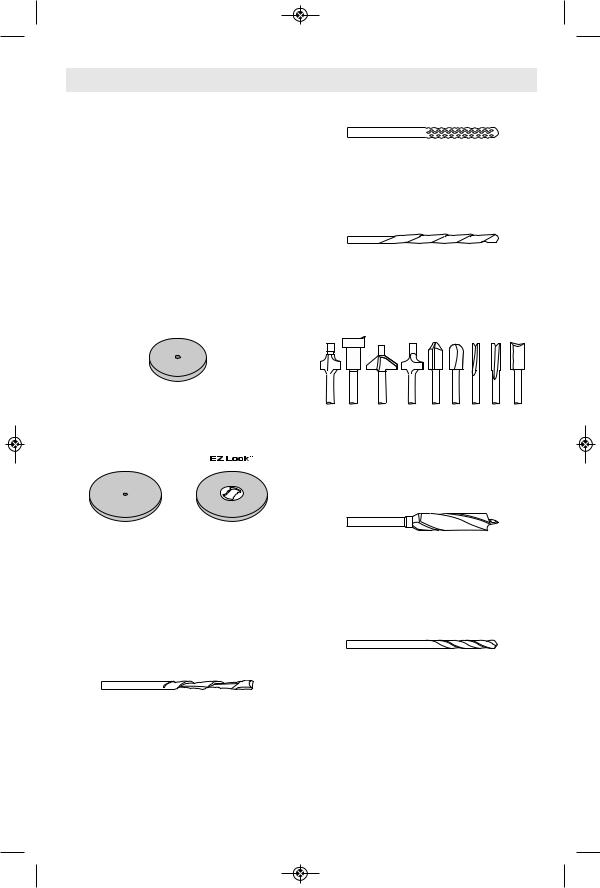
Dremel Accessories (Continued)
cult places, and other sanding jobs. You replace the sanding bands on the drum as they become worn and lose their grit. Bands come in fine medium and coarse grades. Flapwheels grind and polish flat or contoured surfaces. They are used most effectively as a finishing sander after heavier surface sanding and material removal is completed. Flapwheels come in fine and coarse grades. Buffs are a great finishing accessory for cleaning and light sanding. They work effectively on metal, glass, wood, aluminum and plastics. Coarse and medium buffs are sold together. All buffs are sold individually.
Do not exceed 15,000 RPM in speed. 1/8" shank.
Grinding Wheel
Use for deburring, removing rust, and general purpose grinding. Use with Mandrel #402.
Tile Cutting Bit
Cuts ceramic wall tile, cement board, and plaster. Use with Dremel No 565/566 Cutting Guide attachment.
Spiral Cutting Bit
Cuts through all types of wood and wood composites. Use with Dremel No 565/566 Cutting Guide attachment.
High Speed Router Bits
For routing, inlaying, and mortising in wood and other soft materials. Use with Dremel No. 335 Router attachment and No. 231 Shaper/Router table.
Cutting Wheels
These thin discs of emery or fiberglass are used for slicing, cutting off and similar operations. Use them for cutting off frozen bolt heads and nuts, or to reslot a screw head which has become so damaged that the screwdriver won’t work in it. Fine for cutting BX cable, small rods, tubing, cable and cutting rectangular holes in sheet metal.
Drywall Cutting Bit
Gives you fast, clean cuts in drywall. Use with Dremel No 565/566 Cutting Guide attachment.
Brad Point Drill Bits
Titanium coated brad points stay on center and begin drilling immediately. For use on wood. Size 1/8”, 5/32”, 3/16”, ¼” . 1/8” shank.
HSS Drill Bits
HSS drill bit for use in metal and plastic. Size 1/8”, 7/64”, 3/32”, 5/64”, 1/16”, 3/64”, 1/32”. Shank size matches the drill bit size. Different collet size (481, 482, 483) or Dremel chuck (4486) required according to drill bit being used.
19
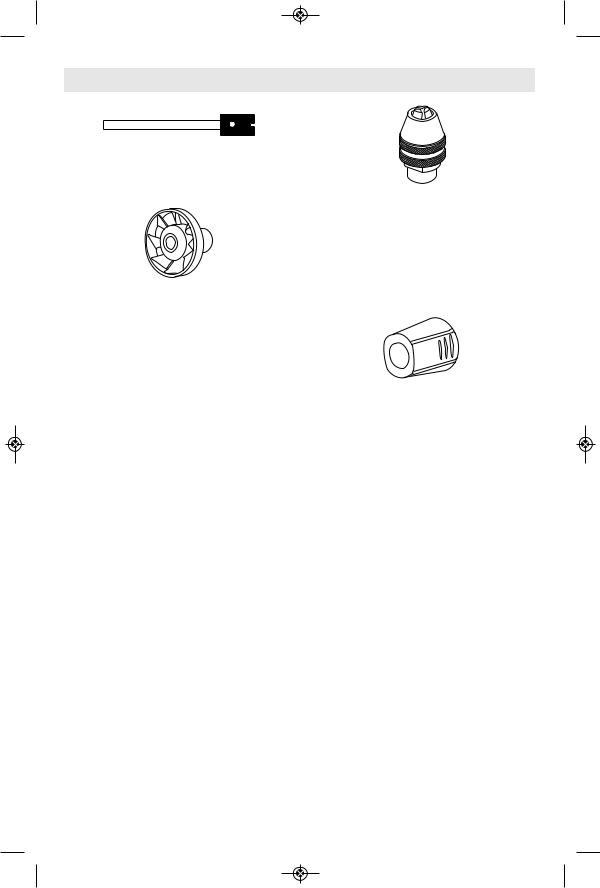
Dremel Accessories (Continued)
Glass Drill Bits
Diamond tipped drill bits for use on glass and ceramic wall tile. Lubricant included.
Collet Fan
Blows dust away for greater visibility to work piece. Great for sanding, engraving and carving. Do not use dust blower to stop or slow down the tool. Do not contact dust blower with fingers or workpiece during use.
Dremel Chuck
This chuck allows you to quickly and easily change accessories on Dremel Rotary Tools without changing collets. Accepts accessories with 1/32” - 1/8” shank. Read instruction manual. Insert and securely tighten the shank of the accessory well within the jaws of the chuck.
Detail Nose Piece
For performing precision tasks a separate nose piece is available in some kits. It has a tapered shape, which allows the user to pinch the nose piece comfortably between thumb and forefinger. It provides an excellent line of sight for performing detailed etching, carving and engraving work.
20
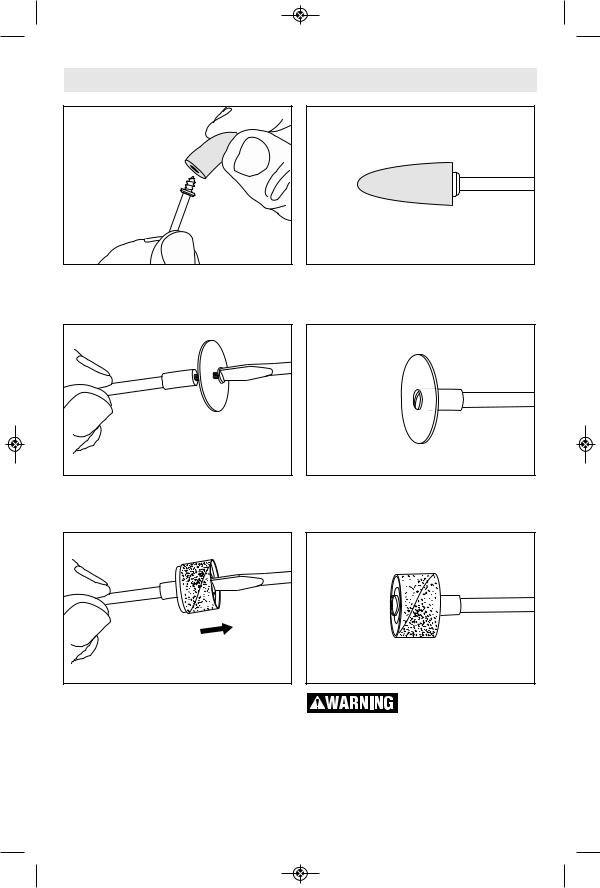
Replacing Screw Mandrel Accessories
Mandrel No. 401 is used with the felt polishing tip and wheels. Thread the tip on to the screw carefully. The felt tip must thread
Mandrel N° 402 has a small screw at its tip, and is used with emery cutting wheels and sanding discs. Higher speeds, usually
To replace a band on the Drum Sander, loosen the screw without removing it to contract the drum then slide the old band off. Slide the new sanding band on and then expand the drum by tightening the screw once again.
down straight on the screw Mandrel, and be turned all the way to the collar.
maximum, are best for most work, including cutting steel. Which is shown here.
Before each use, check to make certain that all components are assembled to accessory
shank and that the drum is sufficiently expanded to secure the band during use. If sanding band is loose on the drum during operation it may “fly” off and strike you or bystanders.
21

EZ Lock™ Operating Instructions
EZ Lock™ Mandrel No. EZ402 has a spring loaded sleeve and is used with cutting wheels, abrasive buffs and polishing cloth.
Always make sure the rotary tool is “OFF” and disconnect the plug from the power
source or the battery pack from the tool before changing accessories. Such preventative safety measures reduce the risk of starting the power tool accidentally.
Always make sure accessory is properly seated on mandrel before use. Incorrect seating of accessory on mandrel may lead to personal injury or property damage.
To load accessory:
1. Place EZ Lock™ mandrel into collet as deep as possible and tighten collet nut. Note: There is a blue spacer that will bottom out on the collet nut, setting the mandrel to the correct depth. When using with Dremel chuck, back the mandrel out slightly before tightening.
2. Pull spring-loaded sleeve DOWN towards tool with one hand and hold. You can brace the tool on the body or work-bench for extra leverage (Fig. 1).
3. With the other hand, align bowtie shape on cut-off wheel with mandrel and make sure metal insert is facing away from the tool (Fig. 2).
4. Place wheel on the mandrel to a point just below the bowtie on the mandrel and twist 90 degrees until the bowtie shape on the wheel aligns with the sleeve. Release sleeve. Wheel should lock in place (Fig. 3).
5. When mounting sanding and polishing accessories, align bowtie with metal insert on bottom of accessory (Fig. 4 & 5).
To check for proper seating, hold shaft lock button and twist accessory. Accessory will not be able to rotate on mandrel. To unload accessory:
1. Pull spring-loaded sleeve DOWN toward tool with one hand (Fig. 1).
2. Hold sleeve down while twisting accessory
90 degrees.
3. Remove accessory.
During use
Avoid damage to EZ lock™ mandrel by not letting it contact the workpiece.
FIG. 1
FIG. 2
FIG. 3
FIG. 4 |
FIG. 5 |
22
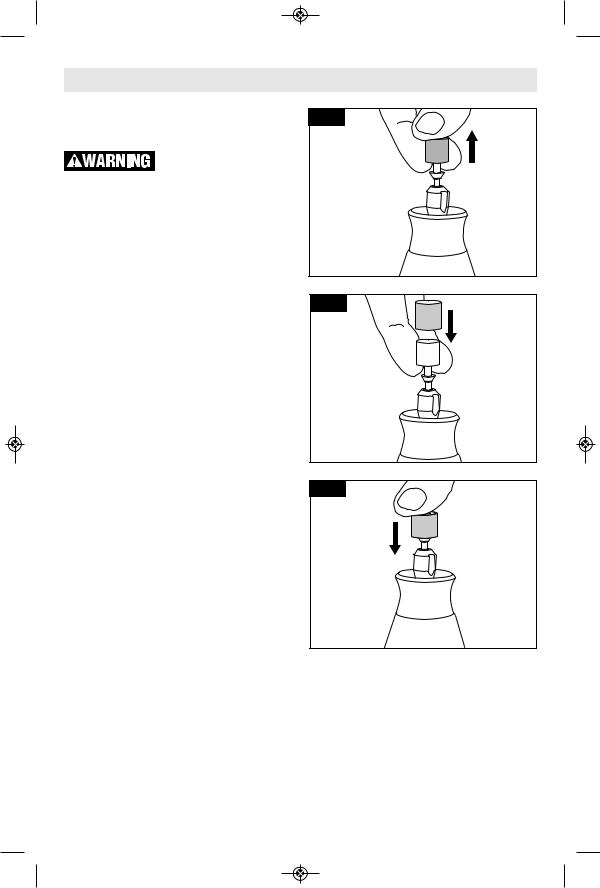
EZ Drum™ Operating Instructions
EZ Drum™ Mandrel No. EZ407SA has a spring loaded sleeve and is used with sanding bands. Always make sure the rotary tool is “OFF” and disconnect the plug from the power
source or the battery pack from the tool before changing accessories. Such preventative safety measures reduce the risk of starting the power tool accidentally.
Always make sure accessory is properly seated on mandrel before use. Incorrect seating of accessory on mandrel may lead to personal injury or property damage.
To load accessory:
1. As indicated, place two fingers underneath the mandrel and pull firmly up. This will place the EZ Drum™ in the "unlocked" position (Fig. 1).
2. Keeping two fingers beneath the mandrel, slide the sanding band down until the entire blue mandrel is covered (Fig. 2).
3. To return to "locked" position, press firmly down on the top of the mandrel (Fig. 3).
Removing the sanding band on the mandrel:
1. Place two fingers underneath the mandrel and pull firmly up. This will place the EZ Drum™ in the "unlocked" position (Fig. 1).
2. Sanding band will now easily slide off mandrel (Fig. 2). Do not squeeze sanding band when removing from EZ Drum™ mandrel. This can lead to rubber band pulling off mandrel and becoming inoperable.
FIG. 1
FIG. 2
FIG. 3
23

Speed Settings
Note: Each number settings listed in the speed charts = x 1,000 RPMs
* Speed for light cuts, Caution - burning on deep grooves.
• Depending on cutting direction relative to grain.
|
|
|
High Speed Cutters |
|
|
|
||
Catalog |
Soft |
Hard |
Laminates |
Steel |
Aluminum, |
Shell/ |
Ceramic |
Glass |
Number |
Wood Wood |
/Plastics |
|
Brass, etc. |
Stone |
|
|
|
100, 121, 131 |
25-35 25-35 |
12-17 |
12-17 |
18-24 |
- |
- |
- |
|
114,124, 134, 144 |
25-35 12-17 |
9-11 |
12-17 |
12-17 |
- |
- |
- |
|
118, 190, 191, 192, |
25-35 |
25-35 |
9-11 |
12-17 |
25-35 |
- |
- |
- |
193, 194 |
|
|
|
|
|
|
|
|
116, 117, 125, 196 |
25-35 12-17 |
9-11 |
12-17 |
12-17 |
- |
- |
- |
|
115 |
25-35 |
25-35 |
9-11 |
12-17 |
12-17 |
- |
- |
- |
198, 199 |
25-35 |
18-24 |
9-11 |
12-17 |
12-17 |
- |
- |
- |
|
|
|
Engraving Cutters |
|
|
|
||
Catalog |
Soft |
Hard |
Laminates |
Steel |
Aluminum, |
Shell/ |
Ceramic |
Glass |
Number |
Wood |
Wood |
/Plastics |
Brass, etc. |
Stone |
|||
105, 108 |
25-35 |
25-35 |
18-24 |
9-11 |
12-17 |
- |
- |
- |
106, 107, 109, 110 |
25-35 |
25-35 |
12-17 |
9-11 |
12-17 |
- |
- |
- |
111 |
25-35* 25-35* |
18-24* |
9-11 |
12-17 |
- |
- |
- |
|
112, 113 |
25-35* 25-35* |
12-17* |
9-11 |
12-17 |
- |
- |
- |
|
|
|
|
|
|
|
|
|
|
|
|
Diamond Wheel Points |
|
|
|
|||
Catalog |
Soft |
Hard |
Laminates |
Steel |
Aluminum, |
Shell/ |
Ceramic |
Glass |
Number |
Wood |
Wood |
/Plastics |
Brass, etc. |
Stone |
|||
7103, 7105, 7117, |
25-35 |
18-24 |
- |
- |
- |
25-35 |
25-35 |
25-35 |
7120, 7122, 7123, |
||||||||
7134, 7144 |
|
|
|
|
|
|
|
|
|
|
|
|
|
|
|
|
|
|
|
|
|
|
|
|
|
|
|
|
Structured Tooth Tungsten Carbide Cutters |
|
|
||||||
Catalog |
Soft |
Hard |
Laminates |
Steel |
Aluminum, |
Shell/ |
Ceramic |
Glass |
|
Number |
Wood |
Wood |
/Plastics |
Brass, etc. |
Stone |
||||
9931, 9932, 9933, |
25-35 |
18-24 |
9-11 |
- |
12-17 |
- |
- |
- |
|
9934, 9935, 9936 |
|||||||||
|
|
|
|
|
|
|
|
||
|
|
|
|
|
|
|
|
|
|
24
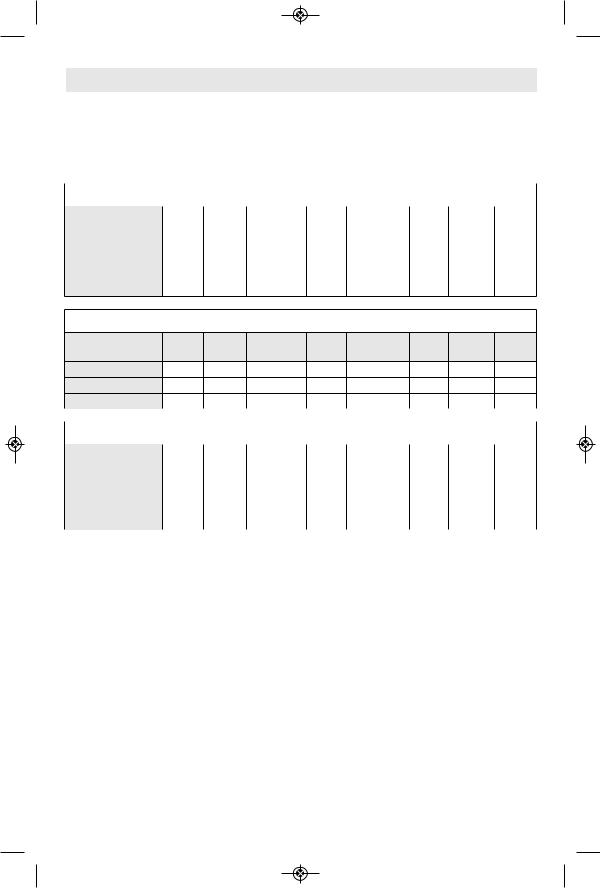
Speed Settings (Continued)
Note: Each number settings listed in the speed charts = x 1,000 RPMs
* Speed for light cuts, Caution - burning on deep grooves.
• Depending on cutting direction relative to grain.
|
|
|
|
|
|
|||
|
|
Tungsten Carbide Cutters |
|
|
|
|||
Catalog |
Soft |
Hard |
Laminates |
Steel |
Aluminum, |
Shell/ |
Ceramic |
Glass |
Number |
Wood |
Wood |
/Plastics |
Brass, etc. |
Stone |
|||
9901, 9902, 9903, |
25-35 |
18-24 |
9-11 |
25-35 |
12-17 |
18-24 |
18-35 |
18-35 |
9904, 9905, 9906, |
||||||||
9912 |
|
|
|
|
|
|
|
|
9909, 9910, 9911 |
- |
- |
- |
- |
- |
18-24 |
18-35 |
18-35 |
|
|
High Speed Router Bits |
|
|
|
|||
Catalog |
Soft |
Hard |
Laminates |
Steel |
Aluminum, |
Shell/ |
Ceramic |
Glass |
Number |
Wood |
Wood |
/Plastics |
Brass, etc. |
Stone |
|||
612, 640 |
25-35* |
18-24• |
- |
- |
- |
- |
- |
- |
615, 617, 618 |
25-35* |
25-35• |
- |
- |
- |
- |
- |
- |
650, 652, 654 |
25-35* |
18-24• |
- |
- |
- |
- |
- |
- |
|
|
|
|
||||||
|
|
|
|
||||||
|
Silicon Carbide Grinding Stones (blue/green) |
|
|
||||||
Catalog |
Soft |
Hard |
Laminates |
Steel |
Aluminum, |
Shell/ |
Ceramic |
Glass |
|
Number |
Wood |
Wood |
/Plastics |
Brass, etc. |
Stone |
||||
83142, 83322, |
|
|
|
|
|
|
|
|
|
83702, 84922, |
- |
- |
12-17 |
25-35 |
9-11 |
12-17 |
25-35 |
25-35 |
|
85422, 85602, |
|||||||||
|
|
|
|
|
|
|
|
||
85622 |
|
|
|
|
|
|
|
|
|
|
|
|
|
|
|
|
|
|
|
|
|
|
|
|
|
|
|
|
|
|
|
|
Abrasive Wheels / Points |
|
|
|
|||
Catalog |
|
Soft |
Hard |
Laminates |
Steel |
Aluminum, |
Shell/ |
Ceramic |
Glass |
Number |
|
Wood |
Wood |
/Plastics |
Brass, etc. |
Stone |
|||
516 |
|
4-6 |
4-6 |
- |
18-24 |
12-17 |
- |
- |
- |
500 |
|
4-6 |
4-6 |
- |
18-24 |
9-17 |
- |
- |
- |
EZ541GR |
|
- |
- |
- |
12-24 |
9-17 |
- |
- |
- |
|
|
|
|
||||||
|
Aluminum oxide grinding stones (orange/brown) |
|
|
||||||
Catalog |
|
Soft |
Hard |
Laminates |
Steel |
Aluminum, |
Shell/ |
Ceramic |
Glass |
Number |
|
Wood |
Wood |
/Plastics |
Brass, etc. |
Stone |
|||
541, 903, 911, 921, |
|
|
|
|
|
|
|
|
|
932, 941, 945, 952, |
25-35 |
25-35 |
- |
18-24 |
9-11 |
12-17 |
25-35 |
- |
|
953, 954, 971, 997, |
|||||||||
8153, 8175, 8193, |
|
|
|
|
|
|
|
|
|
8215 |
|
|
|
|
|
|
|
|
|
25
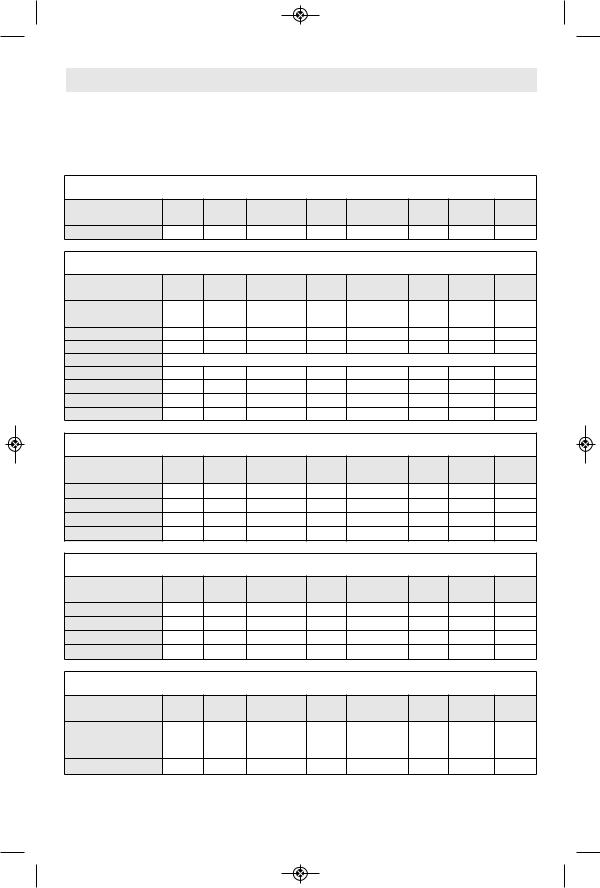
Speed Settings (Continued)
Note: Each number settings listed in the speed charts = x 1,000 RPMs
* Speed for light cuts, Caution - burning on deep grooves.
• Depending on cutting direction relative to grain.
|
|
Chain Saw Sharpening Stones |
|
|
|
|||
Catalog |
Soft |
Hard |
Laminates |
Steel |
Aluminum, |
Shell/ |
Ceramic |
Glass |
Number |
Wood |
Wood |
/Plastics |
Brass, etc. |
Stone |
|||
453, 454, 455 |
- |
- |
- |
25-35 |
- |
- |
- |
- |
|
|
|
Cutting Accessories |
|
|
|
||||
Catalog |
Soft |
Hard |
|
Laminates |
Steel |
Aluminum, |
Shell/ |
Ceramic |
Glass |
|
Number |
Wood |
Wood |
/Plastics |
Brass, etc. |
Stone |
|||||
409, 420, 426, 540, |
- |
- |
|
5-11 |
25-35 |
25-35 |
25-35 |
25-35 |
- |
|
EZ409 |
|
|||||||||
25-35 |
18-35 |
5-11 |
- |
- |
- |
- |
- |
|||
543, EZ544 |
||||||||||
545, EZ545 |
18-35 |
18-24 |
- |
- |
- |
12-24 12-24 |
- |
|||
560 |
12-35 |
For use on drywall. For best results, use at 30,000 rpm |
- |
|||||||
561 |
12-35 |
5-11 |
- |
25-35 |
- |
- |
||||
562 |
- |
- |
|
- |
- |
- |
- |
25-35 |
- |
|
EZ456 |
- |
- |
|
- |
25-35 |
25-35 |
- |
- |
- |
|
EZ476 |
- |
- |
|
5-11 |
- |
- |
- |
- |
- |
|
|
|
Polishing Accessories |
|
|
|
|||||
Catalog |
Soft |
Hard |
|
Laminates |
Steel |
Aluminum, |
Shell/ |
Ceramic |
Glass |
|
Number |
Wood |
Wood |
/Plastics |
Brass, etc. |
Stone |
|||||
461, 462, 463 |
- |
- |
|
- |
18-24 |
18-24 |
18-24 18-24 |
18-24 |
||
414, 422, 429 |
- |
- |
|
- |
12-17 |
12-17 |
12-17 |
12-17 |
12-17 |
|
425, 427 |
- |
- |
|
- |
18-24 |
18-24 |
- |
- |
- |
|
423E |
- |
- |
|
- |
12-24 |
5-8 |
5-8 |
5-8 |
12-24 |
|
|
|
|
|
Wire Brushes |
|
|
|
|
||
Catalog |
Soft |
Hard |
|
Laminates |
Steel |
Aluminum, |
Shell/ |
Ceramic |
Glass |
|
Number |
Wood |
Wood |
/Plastics |
Brass, etc. |
Stone |
|||||
403, 404, 405 |
9-11 |
9-11 |
|
5-11 |
12-17 |
5-8 |
- |
- |
- |
|
428, 442, 443 |
9-11 |
9-11 |
|
5-8 |
9-11 |
9-11 |
- |
- |
- |
|
530, 531, 532 |
- |
9-11 |
|
- |
9-11 |
- |
- |
- |
- |
|
535, 536, 537 |
9-11 |
9-11 |
|
- |
9-11 |
9-11 |
9-11 |
- |
- |
|
|
|
Sanding Bands and Discs |
|
|
|
|||||
Catalog |
Soft |
Hard |
|
Laminates |
Steel |
Aluminum, |
Shell/ |
Ceramic |
Glass |
|
Number |
Wood |
Wood |
/Plastics |
Brass, etc. |
Stone |
|||||
407, 408, 430, 431, |
5-35 |
5-35 |
|
5-17 |
25-35 |
25-35 |
5-35 |
5-35 |
- |
|
432, 438, 439, 440, |
|
|||||||||
444 |
|
|
|
|
|
|
|
|
|
|
411, 412, 413 |
12-17 |
12-17 |
5-8 |
- |
5-8 |
- |
- |
- |
||
26

Speed Settings (Continued)
Note: Each number settings listed in the speed charts = x 1,000 RPMs
* Speed for light cuts, Caution - burning on deep grooves.
• Depending on cutting direction relative to grain.
|
|
|
Flapwheels |
|
|
|
|
|
Catalog |
Soft |
Hard |
Laminates |
Steel |
Aluminum, |
Shell/ |
Ceramic |
Glass |
Number |
Wood |
Wood |
/Plastics |
Brass, etc. |
Stone |
|||
502, 503, 504, 505 |
25-35 |
18-24 |
5-8 |
25-35 |
18-35 |
- |
- |
- |
|
|
Finishing Abrasive Buffs |
|
|
|
|||
Catalog |
Soft |
Hard |
Laminates |
Steel |
Aluminum, |
Shell/ |
Ceramic |
Glass |
Number |
Wood |
Wood |
/Plastics |
Brass, etc. |
Stone |
|||
511E, 512E |
12-17 |
12-17 |
9-11 |
12-17 |
12-17 |
- |
- |
- |
|
|
|
|
|
|
|
|
|
|
|
Detail Abrasive Brushes |
|
|
|
|||
Catalog |
Soft |
Hard |
Laminates |
Steel |
Aluminum, |
Shell/ |
Ceramic |
Glass |
Number |
Wood |
Wood |
/Plastics |
Brass, etc. |
Stone |
|||
EZ471SA, |
5-17 |
5-17 |
5-17 |
5-17 |
5-17 |
- |
- |
- |
EZ472SA, |
||||||||
EZ473SA |
|
|
|
|
|
|
|
|
|
|
|
Drill Bit |
|
|
|
|
|
Catalog |
Soft |
Hard |
Laminates |
Steel |
Aluminum, |
Shell/ |
Ceramic |
Glass |
Number |
Wood |
Wood |
/Plastics |
Brass, etc. |
Stone |
|||
150 |
25-35 |
18-35 |
5-11 |
- |
12-17 |
- |
- |
- |
|
|
|
Glass Drilling Bits |
|
|
|
||
Catalog |
Soft |
Hard |
Laminates |
Steel |
Aluminum, |
Shell/ |
Ceramic |
Glass |
Number |
Wood |
Wood |
/Plastics |
Brass, etc. |
Stone |
|||
662DR, 663DR |
- |
- |
- |
- |
- |
5-17 |
5-17 |
5-17 |
|
|
|
Grout Removal Bits |
|
|
|
||
Catalog |
Soft |
Hard |
Laminates |
Steel |
Aluminum, |
Shell/ |
Ceramic |
Glass |
Number |
Wood |
Wood |
/Plastics |
Brass, etc. |
Stone |
|||
569, 570 |
|
For use on wall and floor grout |
- |
12-24 |
- |
|||
27
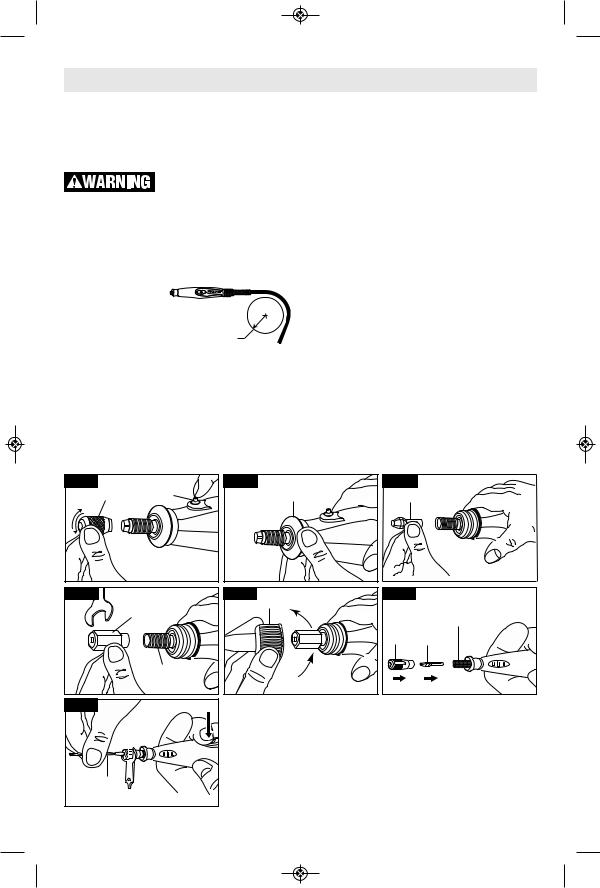
Dremel Attachments
The following attachments are not included with all kits.
Flex Shaft Attachment Model 225
Safety Rules for Flex Shaft
Read the tool manual and these instructions for the use of this accessory with your tool.
Failure to follow all instructions listed below may result in serious personal injury.
Wear ANSI compliant eye protection. The operation of any power tool can result in foreign objects being thrown into the eyes.
Do not operate the |
|
|
flexible shaft with a |
|
|
sharp or multiple |
|
|
bends. Ensure that |
|
|
there are no sharp |
6" RADIUS |
|
residual bends or |
||
|
||
kinks in the flexible |
|
shaft before operation. Over bending the shaft can generate excessive heat on the jacket or hand piece and may cause the flexible shaft to disengage from tool. The minimum recommended bend radius is 6”
Always hold the hand piece firmly in your hands during the start-up. The reaction
torque of the motor, as it accelerates to full speed, can cause the shaft to twist.
Not for use with router bits or other large diameter (1” or larger) bits. Large diameter bits can cause kickback and loss of control when used with the flexible shaft.
Do not remove end ferrule while tool is running. The cable will become loose from the jacket and will uncontrollably whip or lash around.
Installation Instructions
It is extremely important to carefully read and follow the directions to assemble the flexible shaft to your rotary tool below to ensure the tool will function properly.
To properly attach the Flex Shaft to the rotary tool, THREE items must be removed from the tool: the nose cap, Dremel Chuck or collet nut and collet.
1. Press the Shaft lock button 1, unscrew and remove the collet nut or Dremel Chuck 2 (Fig. A1).
FIG. A1 |
2 |
1 |
FIG. A4 |
5 |
|
|
|
6 |
FIG. A7 |
28 |
FIG. A2 |
3 |
|
|
FIG. A5 |
7 |
FIG. A34
FIG. A6 |
|
|
2 |
4 |
8 |
|

2.Unscrew the nose cap 3 from the tool (Fig. A2).
3.Remove the collet 4 (Fig. A3).
Note: If the collet nut and collet are not removed from the motor shaft, the tool will not function properly.
4.Install the driver cap 5 on the motor shaft 6 and tighten (Fig. A4).
To prevent damage to tool, do not overtighten driver cap. Tighten the driver cap finger tight
and then tighten an additional 1/3 turn with the wrench or nose cap. (Wrench included with your rotary tool kit)
5.Attach by screwing the collar of the Flex Shaft 7 to the rotary tool. Make sure the square end of the center core engages the square hole socket in the driver cap (Fig. A5).
6.Refer to “Dremel Chuck” and “Collets” sections of the rotary tool manual for instructions on how to change accessories.
Do not pull out center core to engage into driver cap. This could cause disengagement
of center core from handpiece. If tool stops when shaft is bent, center core may be lodged in driver cap. Loosen shaft and remove core from driver cap. Then screw flexible shaft onto rotary tool housing again.
Operating Instructions
Run-In before Operation
For optimum performance, allow your new flex shaft attachment to run at high speed on your rotary tool in a vertical position for 2 minutes before use (Fig. A7).
Disengagement of the Flex Shaft
The flexible shaft may become disengaged if the motor of your rotary tool is not elevated higher than the working end of the Flex Shaft.
Collet Removal and Replacement
Four different size collets to accommodate different shank sizes, are sold separately for your Flex Shaft. To install a different collet, remove the collet nut 2 and remove the old collet 4. Insert the unslotted end of the collet in the hole in the end of the Flex Shaft 8. Replace collet nut on the shaft (Fig. A5).
Flexible Shaft Lubrication
The Flex Shaft should be lubricated after every 25-30 hours of use. To lubricate, unscrew the Flex Shaft assembly from the motor housing. Pull the center core out of the Flex Shaft assembly. Wipe a very thin film automotive wheel bearing grease on to the center core and reinsert it back into the shaft. To prevent damage to tool do not over grease shaft.
Too much grease will cause the unit to overheat.
Reattach the Flex Shaft to the rotary tool.
FIG. A7 |
29 |
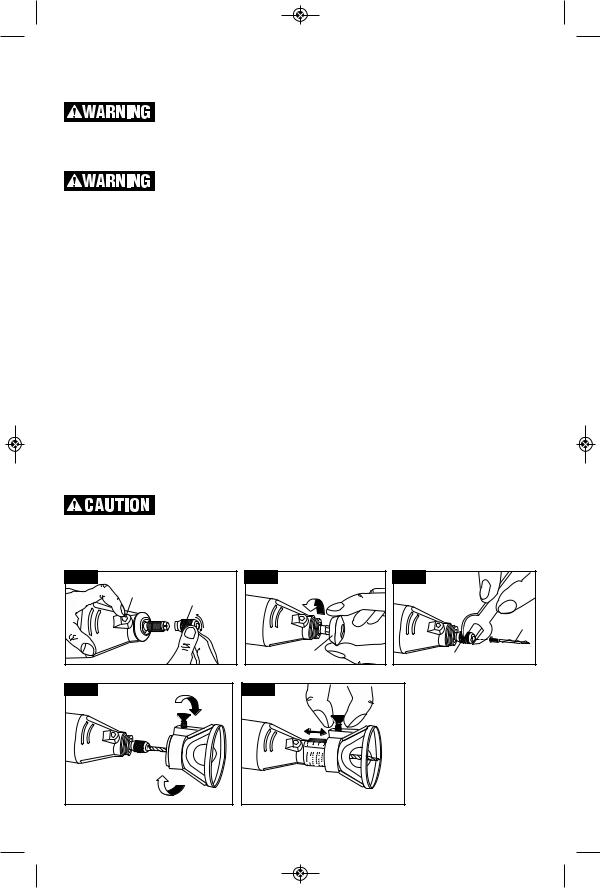
Cutting Guide attachment Models 565 and 566
Read the tool manual and these instructions for the use of this accessory with your tool.
Failure to follow all instructions listed below may result in serious personal injury.
Do not use Dremel chuck with this attachment. Only use a collet and collet
nut.
The cutting guide comes completely assembled and ready to use on a variety of materials up to 3/4" (19 mm) thick. Always hold the tool firmly, using a slow steady pressure to guide the tool through your work. The speed of the tool will do the work.
IMPORTANT: Always cut in clockwise direction except when following a template , then cut in counter clockwise direction.
Cutting Guide Attachment Installation
Instruction
1. Press the Shaft lock button 1, unscrew and remove the collet nut 2 (Fig. B1).
2.Unscrew the nose cap 3 from the tool (Fig. B2).
3.Place the collet nut 2 loosely on the end of the rotary tool and insert the cutting bit 4. Tighten collet nut 2 using the wrench or nose cap (Fig. B3).
When inserting the #560, #561 and #562 Cutting Bit into your Dremel Rotary Tool, be sure that
the bit is securely inserted into the collet. Always use the wrench or nose cap to
tighten the collet nut to prevent the bit from loosening within the collet.
4.Thread the Cutting Guide Attachment 5 onto the exposed housing threads on the rotary tool (Fig. B4).
5.Adjust the attachment to the desired cutting depth (Fig. B5).
560  Drywall Cutting Bit – For use in drywall.
Drywall Cutting Bit – For use in drywall.
Use with 1/8" (3.2 mm) collet #480 and collet nut.
When inserting the #560 bit into your rotary tool, it is very important that at least 1/16” (1.6 mm) and no more than 1/8" (3.2 mm) of smooth shank remains visible above the collet. Leaving too much shank out of the tool can cause the bit to spin unevenly and make the tool difficult to control. The guide has a "0" depth marking on it, however, when inserted properly, the bit will stick out from the end of the guide by 1/16” (1.6 mm) – 1/8" (3.2 mm). The depth can be adjusted from that point on a continuous slide up to 3/4" (19 mm).
When making freehand cuts in drywall – e. g. Repairing a hole in drywall, you may use the #560 Drywall Cutting Bit (cutting in a counter clockwise direction) or the #561 Multipurpose Cutting Bit (cutting in a clockwise direction).
When using a template (like an outlet box) behind the drywall, use the drywall bit #560, cutting in a counter clockwise direction. When
FIG. B1 |
1 |
2 |
FIG. B2 |
FIG. B3 |
|
|
|
|
4 |
|
|
|
3 |
2 |
FIG. B4 |
30 |
FIG. B5 |
